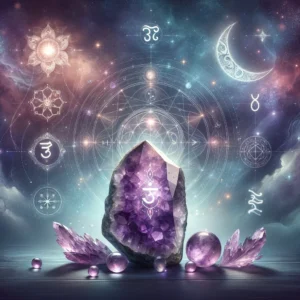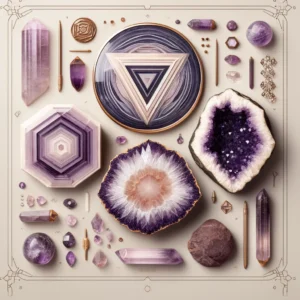Welcome to the world of amethyst, a gemstone as intriguing in history as it is beautiful in appearance. Known primarily for its captivating shades of purple, ranging from light lilac to deep violet, it is a form of quartz that has fascinated civilizations for centuries. This gemstone is not only a feast for the eyes but also a tool for tranquility and spiritual connection.
Amethyst Quick Stats
- Physical Properties: Purple variety of quartz
- Metaphysical Properties: Aids in relaxation, intuition, and inner peace
- Recommended for: Individuals dealing with stress and seeking spiritual connection
Physical Characteristics

Amethyst is the purple variety of quartz and is most noted for its striking coloration, which can vary from a pale, soft lavender to a rich, deep purple. The color is due to irradiation and iron impurities in the quartz. It often displays a vitreous luster, giving it a brilliant sparkle that is enhanced by its various cuts. They can be found in geodes or as crystalline structures, which make it quite popular in both raw and polished forms. Unique inclusions or zoning of color, where hues vary in intensity throughout the crystal, are common and add to the individuality of each piece.
Metaphysical Properties of Amethyst

Historically, amethyst was worn by royalty and used in crowns, scepters, and jewelry as a symbol of protection and wisdom. It is believed to be a powerful and protective stone with a high spiritual vibration. This gemstone is reputed to cleanse one’s energy field of negative influences and attachments. It is also said to open intuition and enhance psychic abilities, making it an excellent stone for meditation and divination.
In the realm of metaphysical properties, amethyst is often associated with the third eye and crown chakras, enhancing spiritual awareness and promoting a higher state of consciousness. Astrologically, it connects with Pisces, Virgo, Aquarius, and Capricorn, and is linked to the element of Air.
Variations and Types of Amethyst

Amethyst is found worldwide, with major deposits in Brazil, Uruguay, and Madagascar. Variations include:
- Chevron Amethyst: Features V-shaped patterns of white quartz and purple amethyst.
- Brandberg Amethyst: A high-vibration crystal from Namibia known for its exceptional clarity and color.
- Amethyst Geodes: Large, hollow rocks lined with amethyst crystals, often used as decorative pieces.
Each type offers different energies and aesthetic appeals, catering to various preferences and uses.
Uses and Applications
Amethyst’s calming and intuitive properties make it ideal for use in meditation and spiritual practices. Placing it in your living space can help to create a tranquil environment, aiding in relaxation and stress relief. It is also popular in jewelry, not only for its beauty but for its ability to stay close to the body and provide continual emotional support.
Who its Recommended For
Amethyst is particularly beneficial for those dealing with stress, anxiety, or emotional turmoil. It is also recommended for individuals seeking to deepen their spiritual awareness or enhance their meditative practices. Its calming properties make it ideal for anyone needing to relax and find inner peace.
Care and Maintenance of Amethyst
To maintain the vibrancy and energy, it should be cleansed regularly. This can be done by rinsing the stone under running water and then charging it in moonlight. Avoid prolonged exposure to direct sunlight as it can fade the color of the amethyst. For storage, keep it in a soft pouch away from harder stones to prevent scratches.
Conclusion
Amethyst is more than just a beautiful stone; it is a beacon of peace, protection, and personal transformation. Whether used in jewelry, meditation, or simply as a decorative piece in your home, it brings a sense of calm and clarity to its surroundings. We encourage you to explore the serene energy of amethyst and share your experiences. Dive into the purple depths of this magical stone and discover the tranquility that awaits!



Leave A Reply